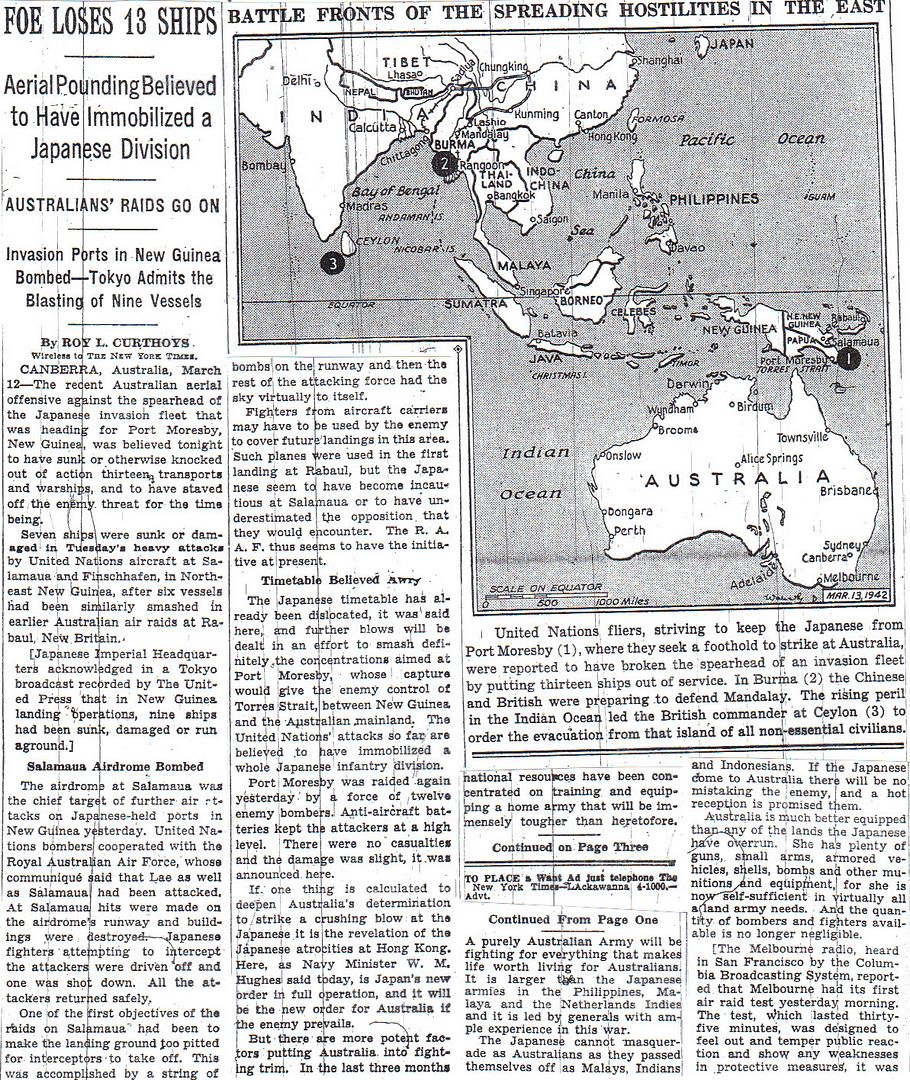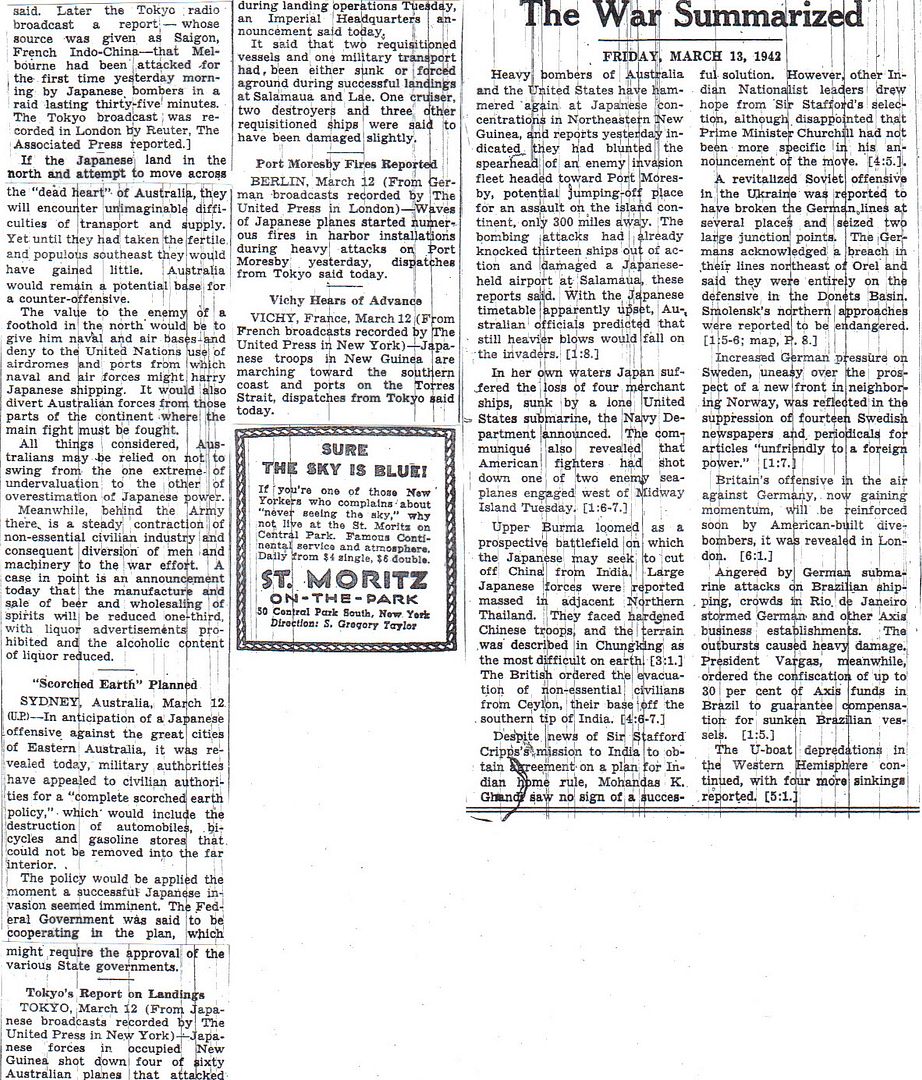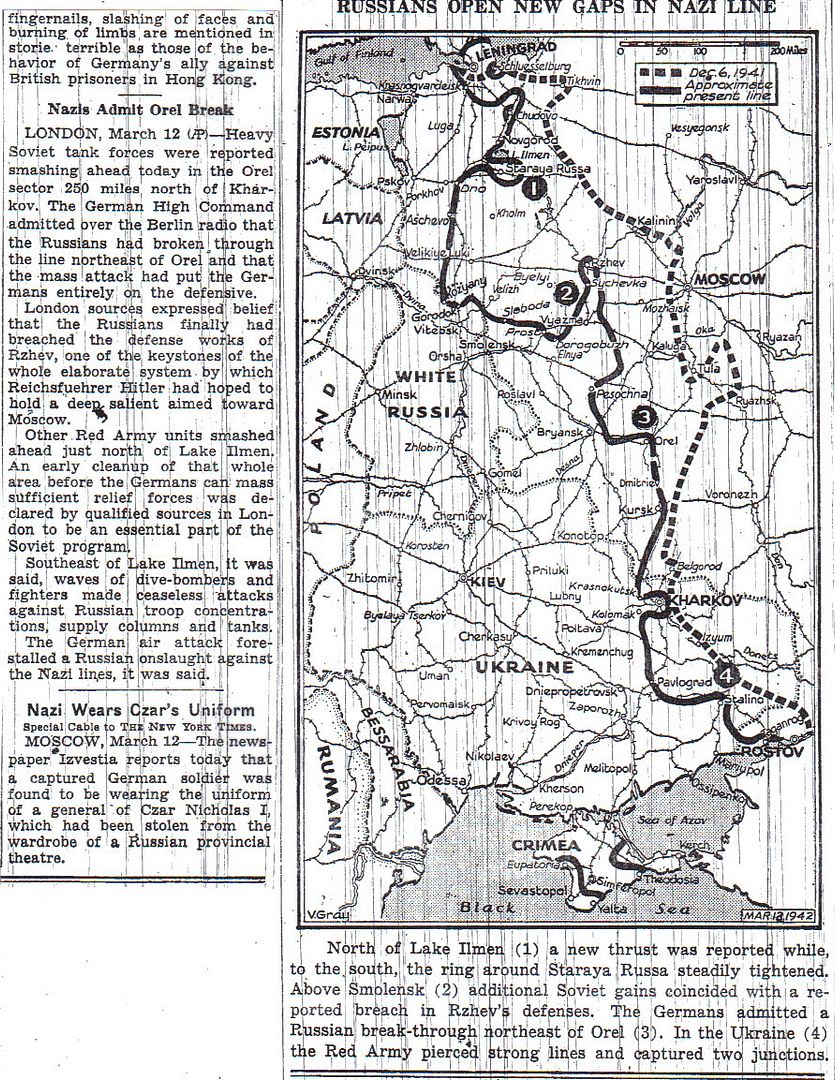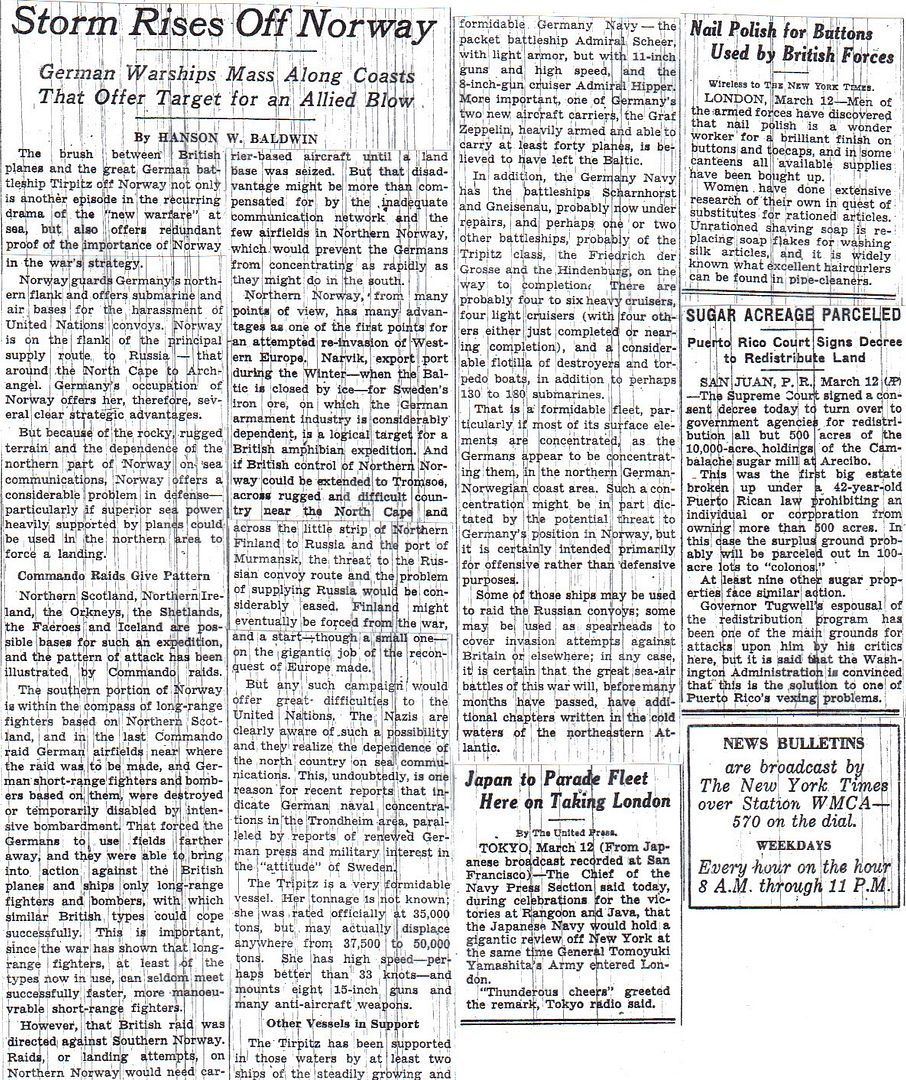
Posted on 03/13/2012 4:23:00 AM PDT by Homer_J_Simpson







http://www.onwar.com/chrono/1942/mar42/f13mar42.htm
Red Army assault in Crimea fails
Friday, March 13, 1942 www.onwar.com
On the Eastern Front... In a mass attack launched from the Kerch Peninsula in the Crimea, the Soviets lose 130 tanks in three days.
http://homepage.ntlworld.com/andrew.etherington/frame.htm
March 13th, 1942
BELGIUM: During the night of the 13th/14th, two RAF Bomber Command aircraft bomb the port area at Ostend. (Jack McKillop)
FRANCE: Ten of 11 RAF Bomber Command Bostons attack the Hazebrouck marshalling yard without loss during the day. During the night of the 13th/14th, seven of the 20 aircraft dispatched bomb the port area at Boulogne (a Wellington is lost); one aircraft bombs the port area at Calais; 11 of 19 Wellingtons dispatched bomb the port area at Dunkirk (two aircraft are lost); and five of seven Hampdens dispatched drop leaflets. (Jack McKillop)
NETHERLANDS: During the night of the 13th/14th, one RAF Bomber Command bomber attacks Schipol Airfield. (Jack McKillop)
GERMANY: During the night of the 13th/14th, RAF Bomber Command dispatches 135 aircraft of 6 different types to attack Cologne; 112 aircraft bomb the target and a Manchester is lost. This can be considered the first successful Gee-led raid. Although there was no moon, the leading crews carrying flares and incendiary-bomb loads locate the target and much accurate bombing follows. It is later estimated that this raid was five times more effective than the average of recent raids on Cologne. There were 237 separate fires and casualties were 62 killed and 84 injured. One aircraft visually bombs Bonn while five Hampdens lay mines in the Frisian Islands. (Jack McKillop)
U-536 laid down. (Dave Shirlaw)
POLAND: Belzec: The second Nazi death camp opens with a transport of 6,000 Jews from Mielec.
U.S.S.R.: The Soviet Army launches an attack against German 11th Army, Army Group South from the Kerch peninsula in the eastern Crimea to relieve Sevastapol. The Soviets lose 130 tanks in three days. (Jack McKillop)
INDIA: The first detachment of U.S. troops (USAAF personnel) to reach the China-Burma-India Theater arrive at Karachi, having been diverted from Java, Netherlands East Indies. (Jack McKillop)
COMMONWEALTH OF THE PHILIPPINES: The two motor torpedo (PT) boats carrying General Douglas MacArthur, his family, Rear Admiral Francis W. Rockwell and their staffs, PT-34 and PT-41, arrive at Cagayan on Mindanao Island in the early morning. Later in the day, a third boat, PT-35, arrives at Cagayan. The three boats had made the 560-mile (901 kilometres) voyage in heavy to moderate seas in two days. The next leg of MacArthur’s journey to Australia is to be by B-17 Flying Fortresses but only one B-17 has reached Del Monte Field and it had wheezed in to a wobbly landing. MacArthur, furious, will allow no one to board the “dangerously decrepit” aircraft, and demands the “three best planes in the U.S. or Hawaii,” manned by “completely adequate, experienced” airmen be flown to Del Monte. Unfortunately, Major General George Brett, Commanding General U.S. Army Forces in Australia, has neither. The party must now await the arrival of three additional B-17 Flying Fortresses from Australia. (Jack McKillop)
The submarine USS Permit (SS-178) arrives at Tagauayan Island and finds the fourth motor torpedo (PT) boat involved in the evacuation of the MacArthur party, PT-32, there. The PT boat is not seaworthy and the submarines takes the boat’s crew aboard and PT-32 is destroyed by gunfire. (Jack McKillop)
NEW GUINEA: The Japanese, having gained firm positions in the Lae-Salamaua area, replace infantry with naval forces. (Jack McKillop)
BISMARCK ARCHIPELAGO: A Japanese force from the 4th Fleet sails from Rabaul, New Britain Island, for Buka Island, Solomon Islands, which is eventually seized together with other positions in the northern Solomons. (Jack McKillop)
PACIFIC OCEAN: Submarine USS Gar (SS-206) torpedoes and sinks a Japanese victualling stores ship between 6 and 10 miles (10 and 16 kilometres) southwest of Mikura Jima, south of Tokyo Bay. (Jack McKillop)
NEW ZEALAND: Japanese submarine HIJMS I-25 launches a Yokosuka E14Y1, Navy Type 0 Small Reconnaissance Seaplane (later assigned the Allied Code Name “Glen”), to recconnoiter Auckland. (Jack McKillop)
U.S.A.: Julia Flikke became the first female Colonel in the US Army (Nurse Corps). (Michael Ballard)
HQ USAAF activates HQ XII Bomber Command at MacDill Field, Tampa, Florida. (Jack McKillop)
ATLANTIC OCEAN: U-404 sinks an unarmed Chilean freighter, SS Tolten, about 28 miles (45 kilometres) east southeast of Asbury Park, New Jersey at 40.10N, 73.50W; there is one survivor from 21 crew. (Jack McKillop)
At 0441, the unarmed and unescorted Colabee was hit by a torpedo from U-126, while she steered a nonevasive course about 10 miles off Cape Guajaba, Cuba. The torpedo was fired on the surface not more than 800 yards away and struck the starboard side at the after end of #2 hold. The explosion created a large hole, blew off the #2 hatch covers and extensively damaged the bridge, killing the master and one man. After the vessel was stopped, the crew of eight officers and 29 men abandoned the ship in panic, because one of the two lifeboats was destroyed and no rafts were aboard. Only ten men get away with the boat, the others jumped overboard and many drowned. U-126 picked up one man, helped him into the lifeboat and questioned the survivors. The ship went aground shortly afterwards. The boat landed on a small Island off Key Verde, Cuba, where the Cuban steam merchant Oriente picked up these 11 survivors and took them to Nuevitas on 15 March. The first engineer and two men stayed with the ship and were taken off the next day at 21.30 hours by American steam tanker Cities Service Kansas. Four officers and 19 men died. Later the Oriente pulled the Colabee off the shoal and was anchored. The Cuban Navy towed her into port, where she was repaired and put back into service.
At 0505, the unescorted tanker John D. Gill was torpedoed by U-158 about 25 miles east of Cape Fear, North Carolina. The vessel on her second voyage had stopped zigzagging for about 20 minutes off Frying Pan Shoals, flashed the running lights and then continued on a zigzag course at 15 knots. One torpedo struck on the starboard side amidships under the mainmast in the #7 tank. The tanker seemed to lift out of the water and move sideways, but the explosion did not ignite the cargo. The oil was ignited when a seaman tossed a life ring with a self-igniting carbide light overboard. The ship and sea was turned in a blazing inferno, forcing the eight officers and 34 crewmen to abandon ship within eight minutes, followed by the seven armed guards (the ship was armed with one 5in, two .50cal and two .30cal guns) seven minutes later. While lowering one of the after boats, the lines became fouled and the occupants were spilled into the sea. At least two of them were killed by the still turning prop. The survivors left the ship in only one of the four lifeboats and one of the six rafts. After abandonment, the tanker was rocked by a series of explosions as one tank after another ignited and exploded. The burned out vessel sank after nine hours. Eight crewmembers and three armed guards were picked up by the US Coast Guard patrol boat #4405, transferred to USCGC Agassiz and landed at Southport, North Carolina. 15 survivors in the lifeboat were picked up by the Robert H. Colley and taken to Charleston, South Carolina. Six officers, 13 crewmen and four armed guards were lost and many of the survivors were badly burned.
U-332 sinks a U.S. schooner about 510 miles (821 kilometres) east of Miami, Florida; there are no survivors; The unarmed and unescorted four-masted schooner Albert F. Paul was reported missing after 11 Mar 1942. On 13 March U-332 spotted a four-masted schooner, which must have been the Albert F. Paul. Liebe considered using his deck gun to sink the ship, but the heavy seas prevented this. A first torpedo passed under the bowsprit, but at 0720 a second torpedo struck under the third mast and the schooner sank immediately.
SS Trepca sunk by U-332 at 37N, 73.25W.
(Dave Shirlaw)
Notice the p6 article about the Puerto Rican sugar cane farm & mill being taken from it’s owners and parceled out.
http://www.sscnet.ucla.edu/soc/faculty/ayala/ayalares/papers/ayalacentro.pdf
From Sugar Plantations to Military Bases: the U.S. Navy’s Expropriations in Vieques, Puerto Rico, 1940-45
Please pardon me for the non-WWII reference, but every historical minded Freeper should check out Hillsdale’s outstanding Constitution 101, now in its’ 4th week.
“Constitution 101: The Meaning and History of the Constitution” is a 10-week online course presented by Hillsdale College. All lessons archived–start anytime!
http://constitution.hillsdale.edu/
Vieques isn’t a large island. For the civilian population, every night must sound like the 4th of July.
A fine example of interscholastic cooperation. Maybe we can arrange a student exchange.
Where does Baldwin get this stuff? The GRAF ZEPPELIN has LEFT the Baltic, and is one of TWO carriers? Two battleships exist that don’t, the FRIEDRICH DER GROSSE and HINDENBURG?
Same kind of thing here with Baldwin. He's latching onto any thread of information that he can find, because there just isn't any real good details. Here's a nice picture of the Graf Zepplin though.

Re the Zepp - did the plans call for an island, or was it supposed to end up looking like that?
It really looks like a liner with the upper decks shaved off and an extention to what became the flight deck.
I don’t believe that it did call for an island on it. But I really don’t know a lot about the ship. It does look like a converted liner with all the port holes. I have no idea what use that would be on a warship.
I found some images that suggests a very narrow and short island about the width of the funnel.
The Germans obviously weren’t stealing designs from the Americans, Japanese, or British.
No, but they may have been stealing from Princess Cruise Lines.
More likely the KdF.
The carrier does look a bit like the MV Wilhelm Gustloff.
Yes, and switch from diesel to steam...
Disclaimer: Opinions posted on Free Republic are those of the individual posters and do not necessarily represent the opinion of Free Republic or its management. All materials posted herein are protected by copyright law and the exemption for fair use of copyrighted works.